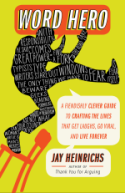In Praise of “Like”
From Thank You for Arguing, by Jay Heinrichs
Let’s use a figure of speech to make up new words. This is dangerous in high school or a government agency, where verbal originality often gets duly punished. You might also face condemnation from people who consider novel usage a linguistic impurity. But the words will come, whether we want them to or not. Better you and I should invent them than some adolescent on the street or, worse, some adolescent behind a computer.
The figure I’m talking about is called anthimeria, or verbing. Language conservatives who want to close our lexical borders hate this figure, because it’s a prodigious neologizer. Calvin in “Calvin & Hobbes” dislikes the anthimeria (he’s surprisingly conservative for a six-year-old). “Verbing weirds language,” he says.
It certainly does. But our language can use some weirding. It freshens things up. Shakespeare certainly thought so. He used verbing to form “bet,” “compromise,” “drugged,” “negotiate,” “puking,” “secure,” “torture,” and “undress,” among many others, and he created even more words by changing verbs to nouns and nouns to adjectives. In an age when the average person had a vocabulary of 700 (today’s college grad averages 3,000), Shakespeare’s exceeded 21,000. He accomplished this by weirding language. If weirding was a turn-on for him (to use a once-popular anthimeria), it positively ecstacizes me.
You can Shakespearicate with some ease simply by turning nouns into verbs or vice versa. I’m not sitting at a desk. I’m desking. Like any kind of wordplay, verbing can distract instead of persuade. But if you need to attentionize an audience, it makes a pretty good tool.
You: The next set of slides show our strategy in detail—so much detail that you might have trouble reading some of the charts. Don’t try to get through them all. I just put them in to give you the big picture. It’s a technique I call Power Pointillism.
Usage abhors a vacuum, and verbing can fill it. For years, grammarians frowned at the use of “contact” as a verb, as in, “I’ll have my secretary contact your secretary.” But words often enter common usage out of need, not ignorance. “Contact” is shorter than “get in touch,” and more general than “call,” “email,” “write,” “meet with,” or “bother.” If you don’t care how the secretaries talk to each other (assuming people still have secretaries), have them achieve contact.
“Impact” gets similar frowns, some of them deserved, when it is used as a verb. A meteor impacts the Earth. A defensive lineman impacts the quarterback. I’d even accept a tax cut that impacts the economy—that runs smack up against it, for better or worse. But when people overuse “impact” as a stand-in for “harm,” I get impatient. “The bird flu impacted South Asia the hardest.” This is metaphornication at its worst. A virus could impact something minuscule, perhaps, just as sperms impact eggs. But I’m sorry, microscopic viruses do not impact South Asia.
Verbing has a subspecies (called, technically, parelcon)—a word that gets stripped of its meaning and used as a filler. Y’know (we’ll call that a word) is an example, and a bad one. Y’know means, um, y’know. I mean, it means “um.”
The word “so”, when used unnecessarily, is another misuse of an anthimeria:
He: So when are you coming?
She: Well, so I was going to come tonight.
He: So are you bringing Lamar?
She: So who’s asking?
This is empty, fruitless talk that only reaps all its “so’s.”
In most cases, “like” commits the same crime. Even the brightest college students toss in “like” liberally, like a heart patient over-salting his fries. It’s unhealthy. It impacts language wellness. But we shouldn’t banish the place-filling “like” altogether. In fact, let’s call it the Rhetorical Like. Used judiciously, the Rhetorical Like serves many subtle purposes. You may not appreciate this next example, but bear with me:
She: I told him I was dating Wen Ho, and he was like, “You’re what?
In this case, “like” serves as a disclaimer of accuracy. (“The following quotation is an approximation, and only an approximation, of my ex-boyfriend’s rhetorical ejaculation.”) Young people often use “like” in this fashion to be ironic. It means, “He said that but not really.” It also expresses ironic distance. (“The views expressed by my ex-boyfriend are not necessarily those held by me.”) So, let’s stretch things a little.
He: So are you, like, freaking or something?
This makes even my teeth hurt a little. But the “like” does serve a purpose—a couple, actually. It inserts a pause, like a rest in music, to place more emphasis on the sentence’s key word, “freaking.” And it gives “freaking” a broader connotation, as in, “Are you something in the nature of freaking?”
So: even meaningless words have meaning. Place-fillers tend to change from generation to generation. “Y’know” was my generation’s, and “like” is the filler of choice for the generation coming of age today. Why the evolution? Maybe my generation was (rightly) uncertain about its ability to communicate. “Y’know” meant “Are you with me? Do you get what I’m saying?”
“Like,” on the other hand, reflects a group too timid to stand firmly on one side of anything. This generation is an ambiguous one, which, from a rhetorical standpoint, may not be so bad. But if you want a consensus, irony eventually has to give way to commitment. Otherwise it’s, like, so wishy-washy.

